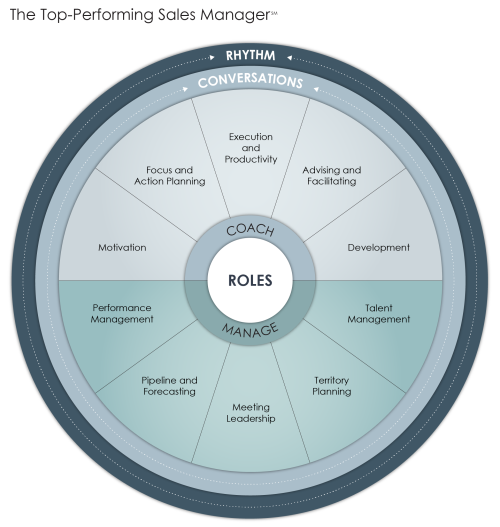ATD Blog
Sales Managers Are the Key to Making Sales Training Stick
Mon Oct 09 2023

How do we make sales learning stick?
I’m asked this frequently, and my response is always the same: Do you have exceptional sales managers? Are you investing in their development?
The answers to these questions often determine the effectiveness of learning retention.
The reason? Sellers find interesting those things that interest their manager. The focus of sales managers inevitably becomes the focal point for the entire sales team, regardless of if we consciously acknowledge it.
When managers prioritize skill development, skill application, sustainment, and accountability, we witness remarkable performance improvements over time.
This is the secret to making learning stick.
While sales managers are the crucial linchpins to successful sales enablement, it takes a collaborative effort between enablement professionals, managers, and sellers. It also requires active involvement from senior leaders to ramp up performance to the next level.
When leadership shows a keen interest, consistently checking in, and holding sales managers accountable for these crucial activities, they create a cascading effect of focus and accountability. This, in turn, propels the application of learning and drives the desired performance improvements.
In this article, I share how sales leaders and enablement professionals can ensure sales managers are supporting sellers so learning sticks.
The Roles Sales Managers Play
Consider the multiple roles sales managers must fulfill.

Sales managers must effectively manage their team’s performance, accelerate performance growth, and address underperformance. They must provide reliable forecasts, oversee pipeline activities, lead productive team meetings at appropriate frequencies, excel at territory planning, and recruit, onboard, and upgrade talent.
The job of a sales manager is undeniably challenging, and finding the time to accomplish everything can be tough, but this clear roadmap charts the way forward. Organizations must focus on and develop these areas in sales managers to achieve top performance in sales teams over time.
A study from the RAIN Group Center for Sales Research found that sellers have a 63 percent higher likelihood of becoming top performers when these three key factors converge:
1. Sellers need the skills and capabilities to be top performers, which can be achieved through effective training. (However, this alone is insufficient. The odds of reaching top performance increase significantly when the following two factors are in place.)
2. Sellers have effective managers.
3. Sellers receive regular coaching.
The combination of these elements is powerful, resulting in a remarkable boost in performance. The significance of getting all three areas right within your organization cannot be overstated.
Based on our experience, we’ve seen that integrating sales managers into the sales training process makes them more effective managers who provide consistent and impactful coaching—a win-win scenario.
Sales Managers as High-Performance Coaches
Let’s take a closer look at coaching.
Exceptional sales managers see themselves as coaches. They position themselves on the sideline, not on the field, with the goal of not only supporting top performers but also identifying and developing them.
Contrary to popular belief, successful sales organizations don’t solely benefit from their brand or recognition. Top performers aren’t exclusively attracted to big brands. In fact, many benchmarked top-performing sales organizations are relatively unknown. Their success stems from their effective methods of identifying sales talent and commitment to continuous and sustained development.
This enhances retention. When sellers thrive in an environment that fosters progress, not just target achievement, they tend to stay longer and perform better.
Countless times I’ve heard, “My team is capable; they know where to find me if they need help. I don’t need to schedule regular coaching sessions.” Furthermore, they argue that they are too occupied with other priorities. This sentiment is all too common, and it’s important to challenge it.
Let’s examine the data—what does it reveal about this attitude? Here’s a remarkable finding from our research: Top performers are 51 percent more likely to receive a regular schedule of ongoing coaching from their sales managers.
This finding validates what we’ve been advocating for years—a consistent rhythm of prearranged and focused coaching interactions, both individually and as a team.
What does that rhythm look like?

Setting a coaching rhythm entails breaking down necessary tasks and allocating time accordingly. It involves quick check-ins, accountability checks, skill reviews, sales meetings, pipeline assessments, upskilling initiatives, and team-building exercises. Naturally, you must adapt and tailor this framework to suit your needs and execute it accordingly. The key is to avoid blending activities and instead reduce wasted time.
Establishing a regular coaching rhythm with your sales team is critical, even though it may be challenging. The returns you’ll reap are far greater than the effort invested. With clearly defined expectations and consistent accountability, any initial grumbles will give way to heightened levels of responsibility. By implementing this rhythm, you’ll unlock development opportunities, improve skill-building initiatives, and foster team growth as a natural consequence.
Don’t Neglect Developing Sales Managers
I strongly recommend that sales managers attend training alongside the sellers they’re responsible for developing. Remember, as a seller, I find what interests my manager interesting.
When sales leaders demonstrate a genuine interest in the development of their sellers, the impact extends not only to the sellers themselves but also to the growth and learning of the sales managers. It’s a symbiotic relationship with profound implications.
Prioritize the development of sales managers and sellers rather than focusing solely on the latter. It is a crucial and often overlooked point. Once again, the returns on collective development will surpass those of isolated individual growth.
Embrace Accountability
To drive progress effectively, embrace accountability—a concept often misunderstood or dismissed. Accountability and discipline are not negative words; they’re essential for success and peak performance in our field. We sometimes associate them with monotony and repetitiveness, but as human beings, we require some structure to achieve effectiveness and excel. Regular accountability driven by managers helps us to excel.
Pursue Simulated Learning
I’m a strong advocate for simulated learning. Some may consider this synonymous with role-playing, but it goes beyond that. Simulated learning involves creating environments that closely resemble buyer-seller interactions. You can glean powerful insights by putting sellers in these environments and holding them accountable for preparing and executing conversations akin to real-life scenarios. The observations obtained from such simulations empower managers to coach more effectively.
Moreover, compared to in-field observations, simulated learning can be implemented more quickly and easily, especially when dealing with geographically dispersed sales teams. Explore possibilities offered by simulated learning, as numerous technologies are emerging in this space.
What Happens When Learning Sticks
Imagine the transformation you can create in your sales team by following this advice. When learning sticks and is applied, you gain improved sales productivity and well-rounded, versatile sellers. You eliminate the need to constantly recruit top talent—the number 1 challenge faced by sales leaders according to our recent study—because your team will become more productive, achieving more with fewer resources. You develop your top performers and retain valuable talent that craves growth and development opportunities. These efforts also help you overcome other common sales challenges as you establish an ongoing development plan.
Ultimately, when you cultivate an ecosystem that prioritizes the development of both sellers and sales managers within your organization, you not only achieve the organization’s priorities more effectively and consistently but also create a thriving environment where growth and excellence become the norm.
You've Reached ATD Member-only Content
Become an ATD member to continue
Already a member?Sign In
More from ATD
